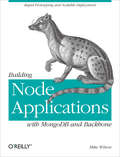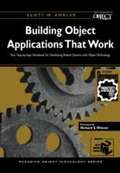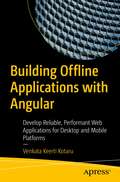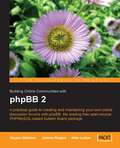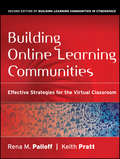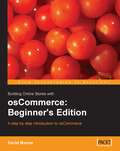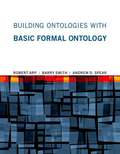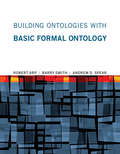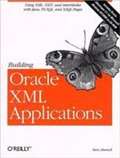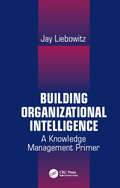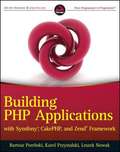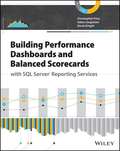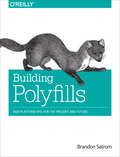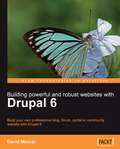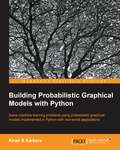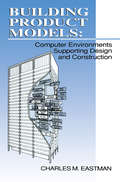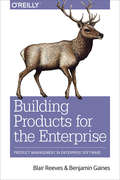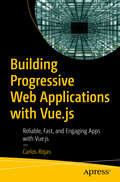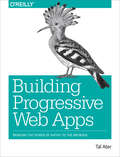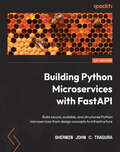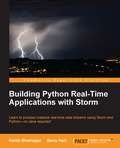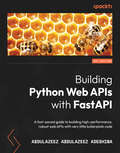- Table View
- List View
Building Node Applications with MongoDB and Backbone: Rapid Prototyping and Scalable Deployment
by Mike WilsonBuild an application from backend to browser with Node.js, and kick open the doors to real-time event programming. With this hands-on book, you’ll learn how to create a social network application similar to LinkedIn and Facebook, but with a real-time twist. And you’ll build it with just one programming language: JavaScript.If you’re an experienced web developer unfamiliar with JavaScript, the book’s first section introduces you to the project’s core technologies: Node.js, Backbone.js, and the MongoDB data store. You’ll then launch into the project—a highly responsive, highly scalable application—guided by clear explanations and lots of code examples.Learn about key modules in Node.js for building real-time appsUse the Backbone.js framework to write clean browser code, and maintain better data integration with MongoDBStructure project files as a foundation for code that will arrive laterCreate user accounts and learn how to secure the dataUse Backbone.js templates to build the application’s UIs, and integrate access control with Node.jsDevelop a contact list to help users link to and track other accountsUse Socket.io to create real-time chat functionalityExtend your UIs to give users up-to-the-minute information
Building Object Applications That Work: Your Step-by-Step Handbook for Developing Robust Systems with Object Technology
by Scott W. AmblerA must-have resource for designers and testers of today's OO applications, the book takes you thru the entire process of building object applications.
Building Offline Applications with Angular: Develop Reliable, Performant Web Applications for Desktop and Mobile Platforms
by Venkata Keerti KotaruGet a complete overview of offline installable applications. Businesses need reliable applications that enable users to access data and their applications in spite of a bad network connection. Traditional websites work only when connected to the network. With a large number of users depending on mobile phones and tablets for work, social interactions, and media consumption, it’s important that the web applications can work on a weak network connection and even offline. This step-by-step guide shows you how to build an Angular application that considers offline access and uses its ready-made features and configurations. Build Offline Applications with Angular helps bridge the gap between native apps and web applications.What You Will LearnGet started with an installable Angular applicationUnderstand the importance of performant, reliable, and offline access of a web applicationDiscover solutions for building Angular applications for speedy response in low bandwidth scenariosUse IndexedDB as an offline data store within a browserWho Is This Book ForIdeal for beginner-to-intermediate-level readers with basic understanding of JavaScript and Angular.
Building Online Communities with phpBB
by Stoyan Stefanov Jeremy Rogers Mike LotharThis book takes a practical, hands-on approach to phpBB. Packed with sections stepping you through tasks, this book is the ideal guide to learning phpBB. Reference appendices make this a really comprehensive source. This book is written by phpBB enthusiasts for new and intermediate users. It's ideal if you are just starting with online communities and want a powerful and free tool, or if you've already started with phpBB and want to take it further. Anyone with a basic knowledge of HTML and a willingness to learn about phpBB will benefit from this book.
Building Online Learning Communities
by Keith Pratt Rena M. PalloffBuilding Online Learning Communities further explores the development of virtual classroom environments that foster a sense of community and empower students to take charge of their learning to successfully achieve learning outcomes. This is the second edition of the groundbreaking book by Rena Palloff and Keith Pratt and has been completely updated and expanded to include the most current information on effective online course development and delivery. A practical, hands-on guide, this resource is filled with illustrative case studies, vignettes, and examples from a wide variety of successful online courses. The authors offer proven strategies for handling challenges that include: Engaging students in the formation of an online learning community.Establishing a sense of presence online.Maximizing participation.Developing effective courses that include collaboration and reflection.Assessing student performance.Written for faculty in any distance learning environment, this revised edition is based on the authors many years of work in faculty development for online teaching as well as their extensive personal experience as faculty in online distance education. Rena M. Palloff and Keith Pratt share insights designed to guide readers through the steps of online course design and delivery.
Building Online Stores with osCommerce: Beginner Edition
by David MercerThis book is written for: first time users of osCommerce current osCommerce who would like to further customize their websites anyone who would like to quickly build a website for their online business
Building Online Stores with osCommerce: Professional Edition
by David MercerThis book is written for anyone who: Already uses OSCommerce, Would like to use OSCommerce, Would like to make a website for their business, Is charged with administering, running and maintaining an OSCommerce site, Is interested in learning how an eCommerce application is created and maintained
Building Ontologies with Basic Formal Ontology
by Robert Arp Barry Smith Andrew D. SpearIn the era of "big data," science is increasingly information driven, and the potential for computers to store, manage, and integrate massive amounts of data has given rise to such new disciplinary fields as biomedical informatics. Applied ontology offers a strategy for the organization of scientific information in computer-tractable form, drawing on concepts not only from computer and information science but also from linguistics, logic, and philosophy. This book provides an introduction to the field of applied ontology that is of particular relevance to biomedicine, covering theoretical components of ontologies, best practices for ontology design, and examples of biomedical ontologies in use.After defining an ontology as a representation of the types of entities in a given domain, the book distinguishes between different kinds of ontologies and taxonomies, and shows how applied ontology draws on more traditional ideas from metaphysics. It presents the core features of the Basic Formal Ontology (BFO), now used by over one hundred ontology projects around the world, and offers examples of domain ontologies that utilize BFO. The book also describes Web Ontology Language (OWL), a common framework for Semantic Web technologies. Throughout, the book provides concrete recommendations for the design and construction of domain ontologies.
Building Ontologies with Basic Formal Ontology (The\mit Press Ser.)
by Robert Arp Barry Smith Andrew D. SpearAn introduction to the field of applied ontology with examples derived particularly from biomedicine, covering theoretical components, design practices, and practical applications.In the era of “big data,” science is increasingly information driven, and the potential for computers to store, manage, and integrate massive amounts of data has given rise to such new disciplinary fields as biomedical informatics. Applied ontology offers a strategy for the organization of scientific information in computer-tractable form, drawing on concepts not only from computer and information science but also from linguistics, logic, and philosophy. This book provides an introduction to the field of applied ontology that is of particular relevance to biomedicine, covering theoretical components of ontologies, best practices for ontology design, and examples of biomedical ontologies in use.After defining an ontology as a representation of the types of entities in a given domain, the book distinguishes between different kinds of ontologies and taxonomies, and shows how applied ontology draws on more traditional ideas from metaphysics. It presents the core features of the Basic Formal Ontology (BFO), now used by over one hundred ontology projects around the world, and offers examples of domain ontologies that utilize BFO. The book also describes Web Ontology Language (OWL), a common framework for Semantic Web technologies. Throughout, the book provides concrete recommendations for the design and construction of domain ontologies.
Building Oracle XML Applications
by Steve MuenchThis rich and detailed look at the many Oracle tools that support XML development shows Java and PL/SQL developers how to combine the power of XML and XSLT with the speed, functionality, and reliability of the Oracle database. The nearly 800 pages of entertaining text, helpful and time-saving hints, and extensive examples can be put to use immediately to build custom XML applications. Includes a CD-ROM with JDeveloper 3.1, an integrated development environment for Java developers.
Building Oracle XML Applications
by Steve MuenchXML (Extensible Markup Language)has emerged as the industry standard for describing data for e-commerce, particularly for business-to-business exchange. Oracle Corporation supports XML in a wide range of products, and the company describes Oracle8 i, its "Internet database" as "the first XML-enabled database." XML is a key part of the company's e-business strategy. Building Oracle XML Applications gives both Java and PL/SQL developers a rich and detailed look at the range of available Oracle XML technologies. The book shows how to combine the power of XML and XSLT with the speed, functionality, and reliability of the Oracle database to build flexible applications. The author delivers nearly 800 pages of entertaining text, helpful and time-saving hints, and extensive examples that developers can put to use immediately to build custom XML applications. Products covered include: XSQL pages and the XSQL servlet JDeveloper XSLT Processor XML Parser interMedia Advanced Queuing The accompanying CD-ROM contains JDeveloper 3.1, an integrated development environment for Java developers.
Building Organizational Intelligence: A Knowledge Management Primer
by Jay Liebowitz"Sharing knowledge is power." If ever there were a field to which this applies, it is the knowledge management industry. And in today's highly-competitive, fast-paced business world, corporations, businesses and organizations in both the public and private sectors are constantly searching for new cutting-edge methods and techniques for creating, storing, capturing, managing, organizing, distributing, combining, and retrieving knowledge. But the task of accomplishing such functions is not as simple as it sounds. Jay Liebowitz's Building Organizational Intelligence: A Knowledge Management Primer gives executives, managers, systems analysts, and other knowledge-management professionals the competitive edge they need in achieving that task. In a concise and easy-to-read format, the book describes the concepts, techniques, methodologies, and tools associated with those functions, and includes mini-case studies and vignettes of how industry is developing and applying these functions towards building organizational intelligence.What's more, the book is packaged with a limited functionality version of "WisdomBuilder," the first in a family of knowledge-management tools that provide a fully integrated solution to the information management and analysis dilemma. Able to run under Windows 95, 98 and NT, "WisdomBuilder" solves the information overload problem by reducing the time and cost of extracting information and other research knowledge from disorganized repositories of heterogeneous data.
Building PHP Applications with Symfony, CakePHP, and Zend Framework
by Bartosz Porebski Karol Przystalski Leszek NowakThe first detailed, unbiased comparison of the three leading PHP frameworks Web developers have been eager for an impartial comparison of leading PHP frameworks so they can make educated decisions about the most effective tool for their needs. This guide uses Symfony, CakePHP, and Zend Framework to solve key problems, providing source code examples and comparisons for each. It explains the approach and reviews the similarities and differences in the three frameworks, providing reliable information on which to base your decisions. Symfony, CakePHP, and Zend Framework are considered the leading PHP frameworks; developers need an unbiased comparison to choose which one works best for their individual situations This guide uses each framework to solve the same problems, illustrating the solutions with source code examples and working applications Covers wide range of topics, from installation and configuration to most advanced features like AJAX, web services and automated testing. Includes an appendix of new PHP frameworks, including CodeIgniter, Lithium, and Agavi Bestselling PHP author Elizabeth Naramore serves as technical editor Comparison of PHP Web Frameworks provides the impartial, side-by-side comparison that developers have been looking for.
Building Performance Dashboards and Balanced Scorecards with SQL Server Reporting Services
by Christopher Price Devin Knight Adam JorgensenDiscover how to maintain and update balanced scorecards and performance dashboards with SQL Server Reporting Services Complementing the bestselling Balanced Scorecards and Operational Dashboards with Microsoft Excel (9780470386811), this indispensable book shows you how to create maintainable and dynamically updated scorecards and performance dashboards using Microsoft's premier reporting tool for the enterprise: SQL Server Reporting Services. The book begins with coverage of performance management methods and metrics and then moves on to introduce you to techniques for developing and delivering both a dashboard and balanced scorecard using Reporting Services. The authors assume very limited knowledge of Reporting Services, allowing you to gradually progress through more advanced topics and solutions. Shows you how to build a simple dashboard and balanced scorecard utilizing helpful examples Discusses formatting controls and labels, paging, and conditional formatting Introduces the skills necessary to make Reporting Services dashboards and scorecards interactive Covers the visual aspect of dashboards and scorecards and shows how to design and implement dashboards and scorecards in Reporting Services for mobile devices Explains how to apply the techniques covered earlier in the book for specific business applications This book sets itself apart from other titles with its comprehensive and invaluable coverage of key strategies and techniques for effectively using SQL Reporting Services to create scorecards and dashboards.
Building Personality-Driven Language Models: How Neurotic is ChatGPT (Synthesis Lectures on Engineering, Science, and Technology)
by Karol Przystalski Jan K. Argasiński Natalia Lipp Dawid PacholczykThis book provides an innovative exploration into the realm of artificial intelligence (AI) by developing personalities for large language models (LLMs) using psychological principles. Aimed at making AI interactions feel more human-like, the book guides you through the process of applying psychological assessments to AIs, enabling them to exhibit traits such as extraversion, openness, and emotional stability. Perfect for developers, researchers, and entrepreneurs, this work merges psychology, philosophy, business, and cutting-edge computing to enhance how AIs understand and engage with humans across various industries like gaming and healthcare. The book not only unpacks the theoretical aspects of these advancements but also equips you with practical coding exercises and Python code examples, helping you create AI systems that are both innovative and relatable. Whether you’re looking to deepen your understanding of AI personalities or integrate them into commercial applications, this book offers the tools and insights needed to pioneer this exciting frontier.
Building Polyfills: Web Platform APIs for the Present and Future
by Brandon SatromAdd custom features to browsers old and new by writing polyfill libraries, JavaScript plugins that take browsers beyond their native capabilities. In this practical fieldbook, author Brandon Satrom introduces principles and guidelines for polyfill development, and then walks you through the steps for building a complex, real-world HTML5 polyfill.You’ll also explore the future of polyfilling—or prollyfilling—that will enable you to test and work with emerging concepts, often ahead of browser vendors. By the time you finish this book, you’ll have the tools and hands-on experience you need to build reliable polyfills for today’s and tomorrow’s Web.Learn the current state of polyfills, including shims, opt-ins, and drop-insUse principles and practices to build responsible polyfills that benefit the entire web development communityBuild out several features for an HTML5 Forms polyfill libraryConfigure a build environment and run automated cross-browser testingOptimize performance, handle edge cases, and fine-tune the speed of your polyfillGet examples of prollyfilling libraries that push the boundaries of the WebWrite a sample prollyfill and compare it to current polyfill builds
Building Powerful and Robust Websites with Drupal 6
by David MercerWritten in the same style as the original Drupal title, this book is a pragmatic look at the steps necessary to get a website up and running. Drawing on years of writing experience, David Mercer utilizes a friendly, engaging style that is both clear and concise perfect for the Drupal newbie. This book is for people with little or no experience in website design, people who are not familiar with PHP, MySQL or HTML, and above all people with little to no experience in using Drupal. Even intermediate Drupal users will find this book of interest although it is specifically aimed at pushing beginners up the learning curve.
Building Probabilistic Graphical Models with Python
by Kiran R KarkeraThis is a short, practical guide that allows data scientists to understand the concepts of Graphical models and enables them to try them out using small Python code snippets, without being too mathematically complicated. If you are a data scientist who knows about machine learning and want to enhance your knowledge of graphical models, such as Bayes network, in order to use them to solve real-world problems using Python libraries, this book is for you.This book is intended for those who have some Python and machine learning experience, or are exploring the machine learning field.
Building Product Models: Computer Environments, Supporting Design and Construction
by Charles M EastmanBuilding Product Models thoroughly presents the concepts, technology, and methods now used to work out what will become the building product model - a new, digital representation for architecture, civil engineering, and building construction.Organized into three sections (history, current tools and concepts, and existing efforts and research issues), this resource provides the field of building product modeling with a standard reference as well as a single, comprehensive text for university courses. Until now, all the efforts in building modeling have been reported in research journals and conference proceedings or been made available as draft standards on the Internet. Building Product Models is the only book available on this vital field, bringing together essential aspects of major efforts from the early 1970s to the present.
Building Products for the Enterprise: Product Management in Enterprise Software
by Blair Reeves Benjamin GainesIf you’re new to software product management or just want to learn more about it, there’s plenty of advice available—but most of it is geared toward consumer products. Creating high-quality software for the enterprise involves a much different set of challenges. In this practical book, two expert product managers provide straightforward guidance for people looking to join the thriving enterprise market.Authors Blair Reeves and Benjamin Gaines explain critical differences between enterprise and consumer products, and deliver strategies for overcoming challenges when building for the enterprise. You’ll learn how to cultivate knowledge of your organization, the products you build, and the industry you serve.Explore why:Identifying customer vs user problems is an enterprise project manager’s main challengeEffective collaboration requires in-depth knowledge of the organizationAnalyzing data is key to understanding why users buy and retain your productHaving experience in the industry you’re building products for is valuableProduct longevity depends on knowing where the industry is headed
Building Progressive Web Applications with Vue.js: Reliable, Fast, and Engaging Apps with Vue.js
by Carlos RojasObtain all the necessary tools for developing a progressive web application (PWA) with Vue.js, a modern JavaScript framework. You’ll see how PWAs behave like a regular responsive website and have a similar structure to that of a web application, but feel like a native mobile app. Along the way you’ll take advantage of Vue.js features to build fast, high-performing progressive web apps that work offline. Building Progressive Web Applications with Vue.js starts by explaining the basic concepts and structure of PWAs, and moves on to designing the app shell and other features that distinguish a PWA from simple web pages. In the following chapters, the book talks about the improved web technologies, such as service workers, caching strategies, background sync, and push notifications, that make PWAs powerful.What You Will LearnHarness the power of Vue.js to build PWAs Understand the function and relevance of a manifest fileDiscover service workers and why they are revolutionaryWork with the Cache API and caching strategiesUse IndexedDB, background sync, and push notificationsEnhance your apps with FirebaseImplement the Workbox library in your appsWho This Book Is ForWeb developers who want to venture into building PWAs would find the book useful.
Building Progressive Web Apps: Bringing the Power of Native to the Browser
by Tal AterMove over native apps. New progressive web apps have capabilities that will soon make you obsolete. With this hands-on guide, web developers and business execs will learn how—and why—to develop web apps that take advantage of features that have so far been exclusive to native apps. Features that include fast load times, push notifications, offline access, homescreen shortcuts, and an entirely app-like experience.By leveraging the latest browser APIs, progressive web apps combine all of the benefits of native apps, while avoiding their issues. Throughout the book, author Tal Ater shows you how to improve a simple website for the fictional Gotham Imperial Hotel into a modern progressive web app. Plus:Understand how service workers work, and use them to create sites that launch in an instant, regardless of the user’s internet connectionCreate full-screen web apps that launch from the phone's homescreen just like native appsRe-engage users with push notifications, even days after they have left your siteEmbrace offline-first and build web apps that gracefully handle loss of connectivityExplore new UX opportunities and challenges presented by progressive web apps
Building Python Microservices with FastAPI: Build secure, scalable, and structured Python microservices from design concepts to infrastructure
by Sherwin John TraguraDiscover the secrets of building Python microservices using the FastAPI frameworkKey FeaturesProvides a reference that contains definitions, illustrations, comparative analysis, and the implementation of real-world appsCovers concepts, core details, and advanced integration and design-related topicsImparts context, app templates, suggestions, and insights that are helpful to actual projectsBook DescriptionFastAPI is an Asynchronous Server Gateway Interface (ASGI)-based framework that can help build modern, manageable, and fast microservices. Because of its asynchronous core platform, this ASGI-based framework provides the best option when it comes to performance, reliability, and scalability over the WSGI-based Django and Flask. When working with Python, Flask, and Django microservices, you'll be able to put your knowledge to work with this practical guide to building seamlessly manageable and fast microservices.You'll begin by understanding the background of FastAPI and learning how to install, configure, and use FastAPI to decompose business units. You'll explore a unique and asynchronous REST API framework that can provide a better option when it comes to building microservices. After that, this book will guide you on how to apply and translate microservices design patterns in building various microservices applications and RESTful APIs using the FastAPI framework.By the end of this microservices book, you'll be able to understand, build, deploy, test, and experiment with microservices and their components using the FastAPI framework.What you will learnUnderstand, orient, and implement REST APIs using the basic components of the FastAPI frameworkBuild asynchronous as well as synchronous REST services using the built-in pydantic module and asyncio supportCreate small-scale and large-scale microservices applications using features supported by FastAPIBuild event-driven and message-driven applications using the frameworkCreate an asynchronous and synchronous data layer with both relational and NoSQL databasesPerform numerical and symbolic computations with FastAPIWho this book is forThis book is for Python web developers, advanced Python developers, and backend developers using Flask or Django who want to learn how to use the FastAPI framework to implement microservices. Readers familiar with the REST API and microservices will also benefit from this book. Some parts of the book contain general concepts, processes, and instructions that intermediate-level developers and Python enthusiasts can relate to as well.
Building Python Real-Time Applications with Storm
by Barry Hart Kartik BhatnagarLearn to process massive real-time data streams using Storm and Python--no Java required! About This Book * Learn to use Apache Storm and the Python Petrel library to build distributed applications that process large streams of data * Explore sample applications in real-time and analyze them in the popular NoSQL databases MongoDB and Redis * Discover how to apply software development best practices to improve performance, productivity, and quality in your Storm projects Who This Book Is For This book is intended for Python developers who want to benefit from Storm's real-time data processing capabilities. If you are new to Python, you'll benefit from the attention to key supporting tools and techniques such as automated testing, virtual environments, and logging. If you're an experienced Python developer, you'll appreciate the thorough and detailed examples What You Will Learn * Install Storm and learn about the prerequisites * Get to know the components of a Storm topology and how to control the flow of data between them * Ingest Twitter data directly into Storm * Use Storm with MongoDB and Redis * Build topologies and run them in Storm * Use an interactive graphical debugger to debug your topology as it's running in Storm * Test your topology components outside of Storm * Configure your topology using YAML In Detail Big data is a trending concept that everyone wants to learn about. With its ability to process all kinds of data in real time, Storm is an important addition to your big data "bag of tricks." At the same time, Python is one of the fastest-growing programming languages today. It has become a top choice for both data science and everyday application development. Together, Storm and Python enable you to build and deploy real-time big data applications quickly and easily. You will begin with some basic command tutorials to set up storm and learn about its configurations in detail. You will then go through the requirement scenarios to create a Storm cluster. Next, you'll be provided with an overview of Petrel, followed by an example of Twitter topology and persistence using Redis and MongoDB. Finally, you will build a production-quality Storm topology using development best practices. Style and approach This book takes an easy-to-follow and a practical approach to help you understand all the concepts related to Storm and Python.
Building Python Web APIs with FastAPI: A fast-paced guide to building high-performance, robust web APIs with very little boilerplate code
by Abdulazeez Abdulazeez AdeshinaDiscover FastAPI features and best practices for building and deploying high-quality web APIs from scratchKey FeaturesA practical guide to developing production-ready web APIs rapidly in PythonLearn how to put FastAPI into practice by implementing it in real-world scenariosExplore FastAPI, its syntax, and configurations for deploying applicationsBook DescriptionRESTful web services are commonly used to create APIs for web-based applications owing to their light weight and high scalability. This book will show you how FastAPI, a high-performance web framework for building RESTful APIs in Python, allows you to build robust web APIs that are simple and intuitive and makes it easy to build quickly with very little boilerplate code. This book will help you set up a FastAPI application in no time and show you how to use FastAPI to build a REST API that receives and responds to user requests. You'll go on to learn how to handle routing and authentication while working with databases in a FastAPI application. The book walks you through the four key areas: building and using routes for create, read, update, and delete (CRUD) operations; connecting the application to SQL and NoSQL databases; securing the application built; and deploying your application locally or to a cloud environment.By the end of this book, you'll have developed a solid understanding of the FastAPI framework and be able to build and deploy robust REST APIs.What you will learnSet up a FastAPI application that is fully functional and secureUnderstand how to handle errors from requests and send proper responses in FastAPIIntegrate and connect your application to a SQL and NoSQL (MongoDB) databasePerform CRUD operations using SQL and FastAPIManage concurrency in FastAPI applicationsImplement authentication in a FastAPI applicationDeploy a FastAPI application to any platformWho this book is forThis book is for Python developers who want to learn FastAPI in a pragmatic way to create robust web APIs with ease. If you are a Django or Flask developer looking to try something new that's faster, more efficient, and produces fewer bugs, this FastAPI Python book is for you. The book assumes intermediate-level knowledge of Python programming.
